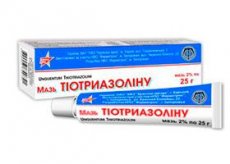Medical expert of the article
New publications
Preparations
Thiotriazoline ointment
Last reviewed: 03.07.2025

All iLive content is medically reviewed or fact checked to ensure as much factual accuracy as possible.
We have strict sourcing guidelines and only link to reputable media sites, academic research institutions and, whenever possible, medically peer reviewed studies. Note that the numbers in parentheses ([1], [2], etc.) are clickable links to these studies.
If you feel that any of our content is inaccurate, out-of-date, or otherwise questionable, please select it and press Ctrl + Enter.

The external preparation – thiotriazoline ointment – refers to preparations for the treatment of wounds and ulcers on the surface of the skin.
Indications Thiotriazoline ointments
Thiotriazoline ointment is used as a therapeutic agent:
- for long-healing wounds with slow granulation and weak epithelialization;
- for trophic ulcers and bedsores;
- for psoriatic skin lesions;
- for dystrophy and inflammation of the periodontium;
- for mouth ulcers.
 [ 1 ]
[ 1 ]
Release form
Thiotriazoline ointment is a colorless or slightly grayish homogeneous mass. The active ingredient is thiotriazoline.
The ointment is packaged in 25 g tubes and packed in a cardboard box.
Pharmacodynamics
The pharmacodynamic properties of thiotriazoline are explained by its membrane-normalizing action, blocking of fat cross-oxidation processes and stimulation of antiradical protection enzymes in the affected layers of the skin and mucous membranes. The listed reactions lead to the cessation of further development of the traumatic inflammatory process, to the acceleration of tissue healing and restoration, to the shortening of the period of post-traumatic rehabilitation.
 [ 2 ]
[ 2 ]
Pharmacokinetics
Thiotriazoline ointment is an external preparation that, when applied at the recommended frequency, does not penetrate into the systemic circulation and does not have a systemic effect on the body.
Thiotriazoline penetrates the oral mucosa in a relatively short time. The maximum content of the active ingredient in the blood plasma is detected within an hour and a half.
Dosing and administration
Thiotriazoline ointment is applied to external skin or mucous membranes.
The preparation is applied to the wound surface, either under a bandage or by an open method. The frequency of application of the ointment is up to 2 times a day every day for 7-20 days.
For gum pathologies, the ointment is placed in the gum cavity in the morning and at night, repeating for 7-14 days.
Use Thiotriazoline ointments during pregnancy
Thiotriazoline ointment can be used without any problems by pregnant and lactating women, if the drug is prescribed by a doctor and is used under his supervision.
Contraindications
The only possible contraindication to the use of Thiotriazoline Ointment may be excessive individual sensitivity to the drug.
Overdose
Overdose of thiotriazoline in ointment form is not considered possible.
Storage conditions
Thiotriazoline ointment is stored in dark places, in a room with a temperature of +12 to +25°C. It is necessary to limit children's access to medications.
 [ 10 ]
[ 10 ]
Shelf life
Thiotriazoline ointment can be stored for up to 2 years from the date of production.
 [ 11 ]
[ 11 ]
Attention!
To simplify the perception of information, this instruction for use of the drug "Thiotriazoline ointment" translated and presented in a special form on the basis of the official instructions for medical use of the drug. Before use read the annotation that came directly to medicines.
Description provided for informational purposes and is not a guide to self-healing. The need for this drug, the purpose of the treatment regimen, methods and dose of the drug is determined solely by the attending physician. Self-medication is dangerous for your health.

